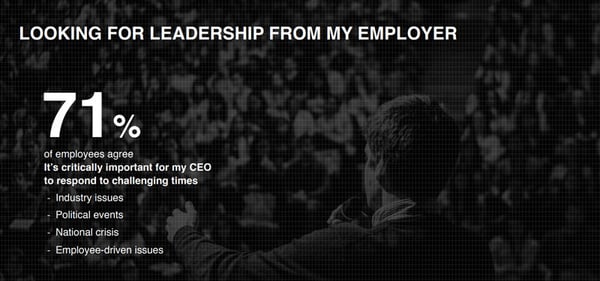
Every business will face a crisis – yet many are unprepared for the impact. Most find themselves caught out by the speed at which news of a crisis spreads. Nearly 70% of brand crises spread internationally within just 24 hours.
While leadership scramble to contain the situation, employees can be left in the dark. It’s a recipe for anxiety, rumors and gossiping online. When a crisis hits, internal communications are in the spotlight. The COVID-19 pandemic is just the latest example communicators have had to contend with.
There are multiple ways in which your employees receive company information. Ensuring these are covered effectively is a big part of crisis management. Staff who are overlooked or who ignore important messages create a huge area of risk.
Using a single multi-channel communications platform enables you to get key messages out faster and more consistently. Here’s why investing in this will help turn your crisis into a triumph – plus six crisis communication tips to improve your messaging success.
1. Strengthen leadership voice
Strong leadership is critical during a crisis. It focuses attention, marshals efforts and provides essential reassurance. In times of crisis, over 70% of employees believe it’s critically important for their leaders to respond.

Simple messages sent through single channels won’t cut it anymore. Leadership response must reflect the situation. Persuasive messaging delivered through multiple channels strengthens your company position.
Key updates delivered through high-impact alerts convey authority. Video messages from the CEO or senior executives convey sincerity and credibility, helping foster valuable emotional connections in times of crisis.
Key themes are reinforced through every channel, assuring employees of the company’s actions and comforting them that their concerns are being addressed.
2. Reduce communication clutter
Communicating leadership messages through a single channel, like email, is ineffective in today’s busy workplaces. Information-overload is high. Distractions abound. Messages are missed.
When every employee receives something like 120 emails every day, what guarantee do communicators have that their important crisis update is seen? The answer: none.
To overcome this, employees have become adept at selecting attention – choosing which messages they read, often unconsciously. If your important crisis comms don’t make it past their selective attention, they won’t be seen.
Delivering messages through multiple, carefully selected channels improves efficiency. It also minimizes the dangers of too many messages being sent through a single overloaded channel. It overcomes employee attention management, giving crisis communications greater prominence and less risk of being ignored.

3. Guarantee readership and response
Crisis response is all about timing. Crisis impact research shows 53% of people expect brands to respond within an hour. For internal communications, that means delivering messages to staff that get read and get acted on – fast.
The power of multi-channel messaging is in delivering the right content through the best channel. Certain channels are suited for high impact, some for eye-catching visuals, while others for encouraging interaction. A multi-channel platform is the ideal crisis communication tool because it maximizes the strengths of each.
An initial announcement, status update or reminder message can be sent through the channel which offers the greatest outcome. That may be increasing awareness, responding quickly or encouraging behavior change. No more ‘one size fits all’ messaging!

4. Engage non-desk-based employees
Traditional communication channels may be fine for traditional workplaces. But many workers today aren’t sitting behind a desk. They’re walking around hospital wards, on warehouse floors, in retail stores or out in the field. Their jobs make them harder to reach, which is critical in times of crisis.
With multi-channel communication you can combine high- and low-tech channels to effectively engage employees in industries like healthcare, manufacturing and retail.
An employee communication app for healthcare workers can instantly advise them of a crisis situation, such as a shooter on site or patient in distress. The visibility of digital signage screens can reach large numbers of frontline or manufacturing workers immediately.

5. Improve performance
Unfortunately, the current crisis won’t be the last. When this one has been resolved, it’s essential to apply the learnings gained to your crisis communication plans. By doing this, your business response will be stronger and return to normalcy faster in any future events.
The measurement and tracking capabilities of multi-channel communications help you to continually refine your crisis planning. Detailed information on message success at company, team or individual level can be accessed in real time. Insights can be exported to identify any ‘communication black spots’ which could introduce risk.
Crises are rarely welcomed, though by applying reporting insights, your crisis communications can grow to be the envy of communicators everywhere.

Protect your staff and business with an effective crisis management plan
Six Crisis Communication Tips to Improve Your Messaging
1. Be thoughtful
The natural reaction by people to a crisis includes anger, hurt, confusion and panic. Whether you agree with it or not, you need to respond to this reaction with compassion.
Ensure your messaging reflects the sentiment you are hearing from the market. Think about how you would want someone else to respond to the situation – with sadness, compassion, outrage? Think carefully about the tone you want to set.
2. Be consistent
You’ll be talking to a variety of audiences through multiple channels. While the messaging is likely to be different for each, your sentiment, tone and brand should be consistent across them all.
3. Be concise
No one wants a long-winded explanation when dealing with a crisis. Keep it brief and focused, without seeming cold and impersonal. Providing accurate information is essential but delivering it with compassion is equally important.

4. Be global
Even if you operate only in one country, you need to be aware your messaging could go global. Email can be shared, as can social posts and media stories. Your crisis could play into what is happening on the global stage and be escalated.
Be conscious of cultural sensitivities and how your message could be interpreted by different audiences. If communicating across multiple countries, consider language translations to ensure there is no misinterpretation of what you’re saying.
5. Be critical
Read your messaging out loud. Is this how you would talk to an employee if they were in the room? Are you leaving questions unanswered? Are you being explicit in what you want someone to do (or not do) having read your message?
While being timely is critical, a little time spent reviewing your message is going to save you from potentially costly mistakes.
6. Be aware
Your pre-planned social messaging, advertising and other promotional activity may no longer be appropriate during a crisis. In an environment where a crisis is impacting entire communities, you may come across as insensitive. Take time to review and potentially postpone the activities you have scheduled.
Abraham Lincoln once said, “I am a firm believer in the people. If given the truth, they can be depended upon to meet any national crisis. The great point is to bring them the real facts.” Multi-channel communications are today’s essential tool to bring his vision to life.


